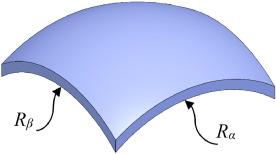当前位置:
X-MOL 学术
›
Int. J. Eng. Sci.
›
论文详情
Our official English website, www.x-mol.net, welcomes your
feedback! (Note: you will need to create a separate account there.)
On mechanics of piezocomposite shell structures
International Journal of Engineering Science ( IF 5.7 ) Pub Date : 2024-03-12 , DOI: 10.1016/j.ijengsci.2024.104056 Mohammad Malikan
International Journal of Engineering Science ( IF 5.7 ) Pub Date : 2024-03-12 , DOI: 10.1016/j.ijengsci.2024.104056 Mohammad Malikan

|
This study presents an original and novel investigation into the mechanics of piezo-flexo-magneto-elastic nanocomposite doubly-curved shells (PFMDCSs) and the ability to detect the lower and higher levels of electro-magnetic fields. In this context, by utilizing the first-order shear deformation shell model, stresses and strains are acquired. By imposing Hamilton's principle and the von Kármán approach, the governing equations have been obtained. The intelligent shell model consists of size-dependent influences, viz., strain gradients. This will take place via Mindlin's strain gradient elasticity theory and the subsequent re-establishing of the mathematical framework by incorporating this concept. The strain gradient results in a flexoelectric/flexomagnetic effect. The converse effect of the magnetic field on the basis of a close circuit has been assumed. The developed bending equations have been transferred into the algebraic ones by substituting an analytical technique based on homogeneous immovable simple support for the four edges. The problem has been solved according to the Newton-Raphson iteration scheme, and transverse deflections have been computed. For researching the rightness and precision of the shell models together with the solution process, a comparison is prepared by the finite element method (FEM) results for simplified shells, and a good correlation has been observed. At last, by examining several factors governing the problem, the conditions under which the magnetic effects can be noticeable and dominant in doubly-curved shells have been sought. This study could serve as a benchmark reference for piezoceramic-DCSs, as the presented governing equations are original. The most interesting outcome of this research is that the electro-magnetic response of intelligent structures can be entirely geometry-dependent.
中文翻译:

压电复合材料壳结构力学研究
这项研究对压电柔印磁弹性纳米复合材料双曲壳(PFMDCS)的力学以及检测较低和较高水平电磁场的能力进行了原创性和新颖的研究。在这种情况下,通过利用一阶剪切变形壳模型,可以获得应力和应变。通过应用哈密顿原理和冯卡门方法,得到了控制方程。智能壳模型由尺寸相关的影响组成,即应变梯度。这将通过明德林的应变梯度弹性理论以及随后结合该概念重新建立数学框架来实现。应变梯度导致挠曲电/挠磁效应。已经假设了基于闭合电路的磁场的相反效应。通过替换基于四个边缘的均匀不可移动简单支撑的分析技术,将所开发的弯曲方程转化为代数方程。该问题已根据 Newton-Raphson 迭代方案求解,并计算了横向变形。为了研究壳模型的正确性和精度以及求解过程,与简化壳的有限元法(FEM)结果进行了比较,观察到了良好的相关性。最后,通过研究影响该问题的几个因素,找到了双曲壳中磁效应明显且占主导地位的条件。这项研究可以作为压电陶瓷 DCS 的基准参考,因为所提出的控制方程是原创的。这项研究最有趣的结果是智能结构的电磁响应可以完全依赖于几何形状。
更新日期:2024-03-12
中文翻译:

压电复合材料壳结构力学研究
这项研究对压电柔印磁弹性纳米复合材料双曲壳(PFMDCS)的力学以及检测较低和较高水平电磁场的能力进行了原创性和新颖的研究。在这种情况下,通过利用一阶剪切变形壳模型,可以获得应力和应变。通过应用哈密顿原理和冯卡门方法,得到了控制方程。智能壳模型由尺寸相关的影响组成,即应变梯度。这将通过明德林的应变梯度弹性理论以及随后结合该概念重新建立数学框架来实现。应变梯度导致挠曲电/挠磁效应。已经假设了基于闭合电路的磁场的相反效应。通过替换基于四个边缘的均匀不可移动简单支撑的分析技术,将所开发的弯曲方程转化为代数方程。该问题已根据 Newton-Raphson 迭代方案求解,并计算了横向变形。为了研究壳模型的正确性和精度以及求解过程,与简化壳的有限元法(FEM)结果进行了比较,观察到了良好的相关性。最后,通过研究影响该问题的几个因素,找到了双曲壳中磁效应明显且占主导地位的条件。这项研究可以作为压电陶瓷 DCS 的基准参考,因为所提出的控制方程是原创的。这项研究最有趣的结果是智能结构的电磁响应可以完全依赖于几何形状。
















































 京公网安备 11010802027423号
京公网安备 11010802027423号